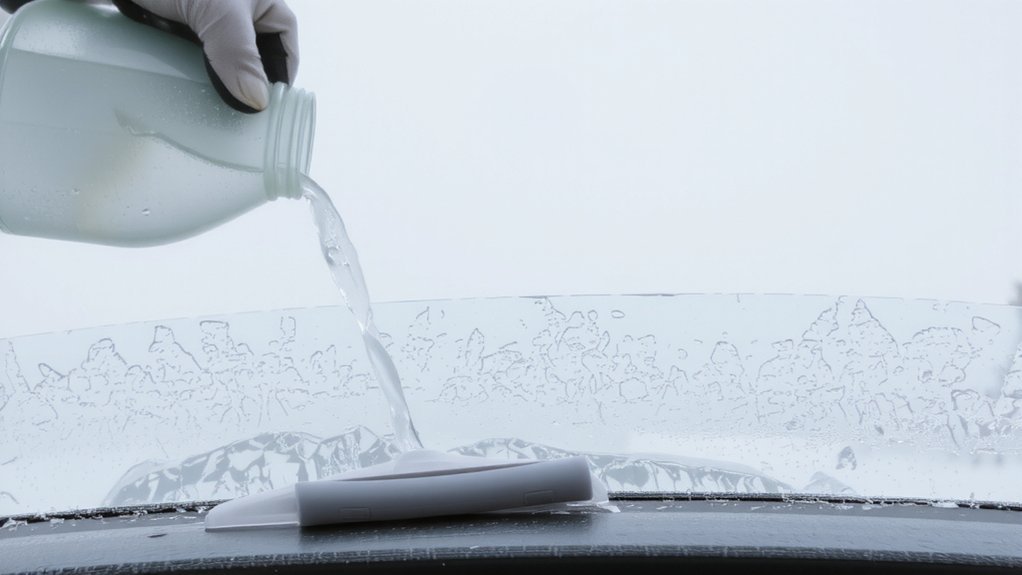You can clear a frozen windshield much faster than you think if you use the right tools and sequence. Start with the basics—lift wipers, warm the cabin, then attack the ice with a scraper and de‑icer—while avoiding common mistakes that slow you down or damage glass. Keep going; the most effective steps come next.
Manual Ice Removal Techniques

Grab a sturdy ice scraper and work in short, controlled strokes, starting from the edges and pushing toward the center to avoid gouging the glass; if you don’t have a scraper, a plastic spatula or credit card can work in a pinch.
Angle the scraper to shave thin layers rather than forcing chunks; that reduces strain and prevents scratches.
Use a soft-bristled snow brush for loose snow, keeping strokes toward the ground so flakes don’t blow back onto the windshield.
Spray a commercial de-icer or a homemade mix (two parts isopropyl alcohol to one part water, with a few drops of dish soap) and let it sit 20–30 seconds before scraping.
Lift wipers, remove ice from blades, and avoid metal chisels or boiling water.
Optimizing Your Defroster System

Start your car and set the climate control to the defrost mode with the fan on high and recirculation off so fresh air can remove moisture; if your system has an A/C button, turn it on to dehumidify the cabin even in cold weather.
Aim warm airflow at windshield, wait for temperature to rise; avoid blasting hottest setting immediately, gradual warming reduces stress on glass.
Activate rear defogger and heated mirrors if equipped.
Clear vents and dash of snow or ice so airflow isn’t blocked.
Use temperature blend to keep glass above freezing while keeping cabin comfortable. If your vehicle offers preconditioning or auto-defrost, program it.
Monitor fogging and switch to fresh air if moisture accumulates. Service heater core, blower, and cabin filter.
Cold Water Application: Safe Use

Although it might seem counterintuitive, you can use cold water safely if you take precautions: pour gently in a slow, steady stream to avoid thermal shock, clear loose snow first, keep water running off the windshield so it doesn’t pool and refreeze, and have a scraper and de-icer ready to remove softened ice.
Aim to use only lukewarm or tepid water, not hot, to prevent cracking.
Start at the edges and work downward so loosened ice drains away.
Use a plastic scraper, not metal, and lift gently rather than forcing.
If temperatures are far below freezing, limit water use and use the defroster and wipers to disperse moisture.
Watch for refreeze on wipers and mirrors, dry seals and surrounding trim afterward to prevent damage.
Chemical Deicing Solutions You Can Make or Buy

When you need something fast, chemical deicers—whether store-bought or DIY—dissolve ice quickly and cut your scraping time;
you’ll want to know their strengths, how to apply them safely, and which formulas to avoid.
Use commercial windshield deicers labeled safe for glass; they use alcohol or glycol blends that melt ice without fogging or damaging seals.
For a DIY option, mix three parts isopropyl alcohol and one part water in a spray bottle—spritz, wait 20–30 seconds, then wipe with a plastic scraper.
Avoid hot water, bleach, or ammonia-based cleaners that can crack glass or strip tint.
Always test a small area, keep products off paint and rubber, and store flammables away from heat.
Carry a small spray in your glovebox for quick morning touch-ups year-round.
Combining Air Conditioning With Heat for Faster Drying

Using your air conditioning while running the heat pulls moisture out of the cabin and sends warm, dry air across the windshield, so you’ll dry glass faster and cut the chance of refreeze.
Turn on the A/C compressor and set the temperature to a comfortable warm level, then use the defrost mode so vents aim at the glass.
Run the blower at medium-high; higher airflow speeds drying.
Disable recirculate so the system pulls in outside air to be dehumidified, unless it’s extremely humid outside.
Monitor windshield clarity and reduce A/C once the glass is dry to save fuel.
This method works quickly and safely without chemicals, letting you drive with clearer visibility sooner.
Avoid prolonged idle to prevent unnecessary fuel use and battery drain.
Window Ventilation Tricks to Reduce Fog and Frost
After you dry the windshield with A/C and heat, keep air moving to stop fog and frost from returning.
Use fresh air (recirculation off) so humid cabin air is replaced.
Aim vents at the windshield and floor—warm air on the glass, cooler air down below reduces condensation.
Run the fan higher; steady airflow prevents microclimates that freeze.
Crack a side window a few inches for quick pressure equalization in very cold, humid conditions.
Keep the A/C engaged briefly to dehumidify even when heating.
Don’t block dash vents with papers or gear.
On longer drives, alternate vent modes to balance comfort and defogging.
When you park, leave a window slightly ajar if safe to avoid trapped moisture that later fogs or frosts the glass again.
Conclusion
You’ve got the tools and steps to clear your windshield quickly and safely. Start by brushing loose snow, lift the wipers, run defrost with fan high, recirculation off and A/C on, and spray de‑icer or a 3:1 alcohol mix before scraping with a plastic tool. Avoid hot water and metal chisels, and use heated mirrors or rear defogger if you have them. Combine warm airflow and ventilation to prevent fog and finish faster today safely.